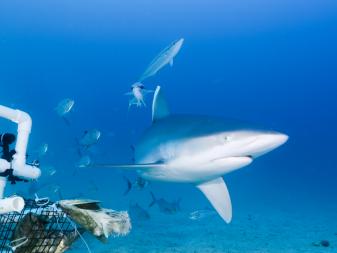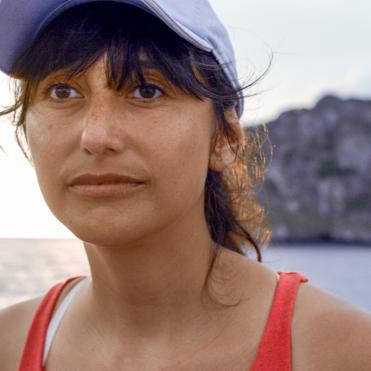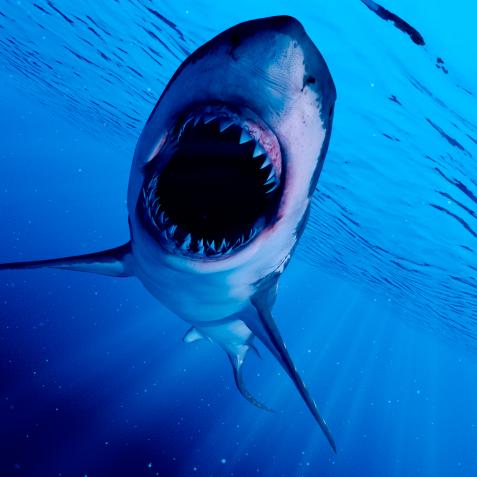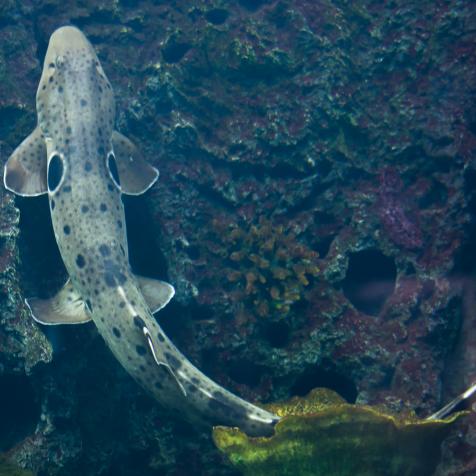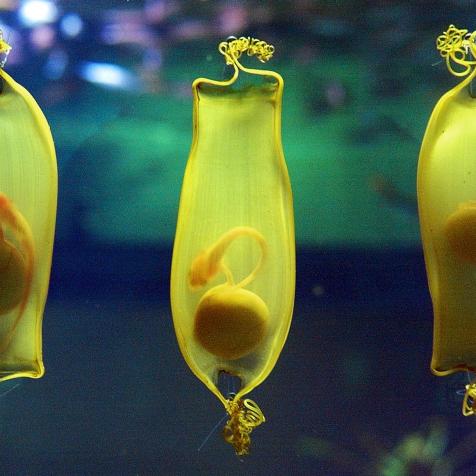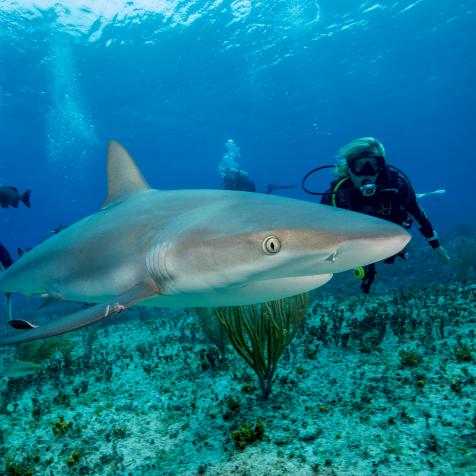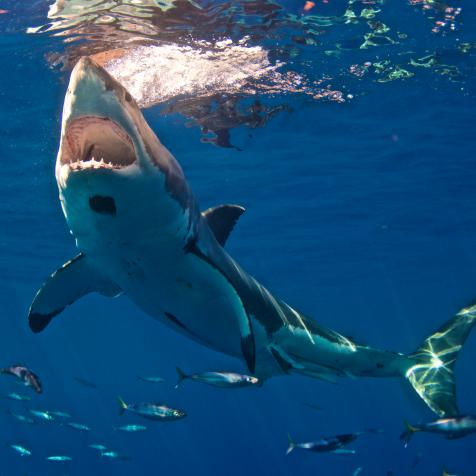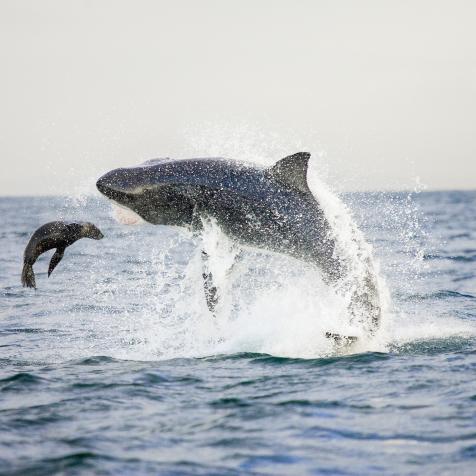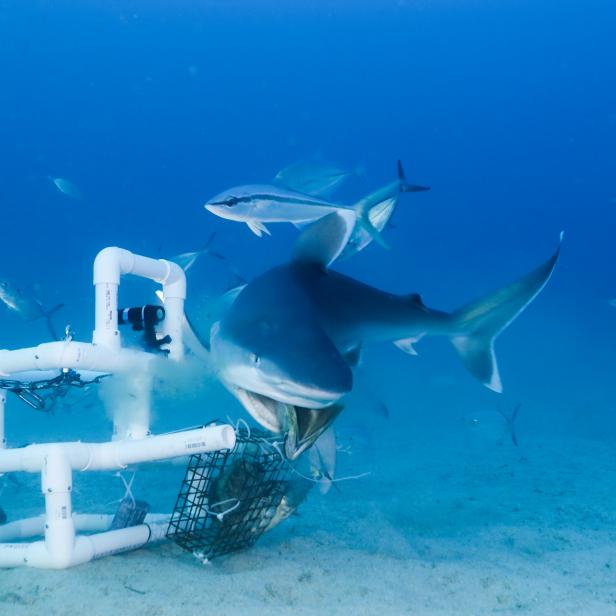
The Shark Tech Behind Rogue Tiger Shark: The Hunt for Lagertha

In the Cocos Islands, the sun danced across the sky in a daily ritual beginning with pink hues that burned to cobalt blue and retreated into deep purples by the day's end. But every moment was focused on using sophisticated marine technology to locate an elusive tiger shark on ROGUE TIGER SHARK: THE HUNT FOR LAGERTHA.
Stream ROGUE TIGER SHARK: THE HUNT FOR LAGERTHA on discovery+.
On the surface, I spent two weeks vacationing in Cocos Island, a tropical island in the Pacific Ocean where the water was warm, and the seas were flat. Despite the picturesque surrounding, what I had really done was join a film crew, on a treacherous diving expedition to deliver the story of a rogue tiger shark, Lagertha. Our mission for Shark Week was challenged with the proverbial ‘needle in a haystack’ because Cocos Island is the first stop along a 500-mile-stretch of shark superhighway.
The Sharks of Cocos Island
Behind the Scenes of Rogue Tiger Shark: The Hunt for Lagertha 21 Photos
A monster lurks in the crystal blue waters off the coast of Costa Rica. In this epic adventure, the experts set off to hunt Lagertha down, and find out why the tiger sharks in the area are so aggressive.Watch SHARK WEEK now Discovery and stream on discovery+.
This bustling commute is utilized by many species, including scalloped hammerheads (Sphyrna lewini), whitetip reef sharks (Triaenodon obsesus), Galapagos sharks (Carcharhinus galapagensis), blacktip sharks (Carcharhinus limbatus), and most importantly to our crew, the tiger sharks (Galeocerdo cuvier). The marine ecosystem encompassing the Cocos Island is undoubtedly a hotspot for sharks, but different species are there for different sharky-business. For instance, whitetip reef sharks appear to make Cocos Island their round-the-clock home base, whereas the tiger sharks patrol these reefs for food and only stick around when they have found it.
To complicate matters, during this expedition we were dealing with an individual that did not play by the typical “shark rules.” Therefore, understanding general shark behavior was only one of the many strategies our crew used in the show. Equipped with a heavy arsenal of marine technology, our crew was ready for deployment the second we arrived to the island.
High-Tech Tools of the Trade

c/o Vicky Vásquez
Deadlier than a rogue tiger shark is the nitrox system used by our expedition’s dive team, which included Dr. Craig O'Connell and cinematographer extraordinaire, Andy Casagrande. One of the most important pieces of shark-tech is certainly the dive equipment. The dangers of nitrox diving are all rooted in the highly concentrated levels of oxygen that are used. From poisoning the diver to injuring anyone in range of a tank explosion, the dive crew and medical team had many reasons to keep a close watch on this equipment. An additional benefit to nitrox diving is that it can reduce fatigue. While facing hefty currents and multiple daily dives, the energy boost was a huge benefit to the mission at hand. However, to be honest, when Andy Casagrande has his eyes on the shark-prize, he launches into a level of beast-mode that even a great white shark would have a hard time keeping up with.
To aid the topside team in monitoring the divers, another cool piece of shark-tech are the intercoms installed into all the dive masks. For someone like myself, this bit of shark-tech was incredibly important since I was part of the topside crew. My communication with the dive team was vital in not only monitoring their safety, but for the deployment of another bit of shark-tech- a fin cam.

c/o Vicky Vásquez
There is some tech that doesn’t even make the final cut of the show, but it doesn’t mean it wasn’t used and valued by the crew. That’s because our team didn’t hold back in bringing everything and anything they could think of, including Dr. O'Connell's very own ‘Fin Cam’. Attached with a small acoustic tag, I sat on the boat, poised with a hydrophone at the ready, waiting for the moment that the dive team successfully attached one of these cameras to a shark. The incredible design with dual-facing cameras meant we could use the sharks of Cocos Island to help us in the search for Lagertha.
The next bit of shark-tech that gave our team some serious bitey-action was the BRUV (which stands for a Baited Remote Underwater Video). A personal favorite of mine, the BRUV consisted of carefully positioned cameras attached to a cube of PVC pipe with a tasty bit of fish-guts ready to attract. What I learned from this trip is how a “simple design” needed intensive monitoring. The benefit of the BRUVs was allowing the team a constant monitoring of the surrounding waters since we could not keep divers in the water at night. This rule that was implemented by the Costa Rican government after the tragic death of a diver killed by the tiger shark we had come to know as Lagertha.

c/o Vicky Vásquez
The underwater monitoring didn’t stop there. Another soldier in Dr. O'Connell’s array of shark-tech is actually a turtle — Myrtle the Robo-Turtle, that is! Myrtle was a lot of fun and definitely proved herself as one of the team. Myrlte’s interesting design included lights and dual cameras to catch the action from in front and behind. The best thing about Myrtle is that she is a remote-operated vehicle, aka a ROV. As a result, the ROV could be maneuvered along the surface and was capable of shallow dives. With the cameras providing a live feed, we could even see what Myrtle saw in real time!

c/o Vicky Vásquez
Myrtle wasn’t the only ROV on board. Since tiger sharks have been reported to cruise regularly at 100 meters below the surface (that’s over 300 feet), with their deepest dives going past 1,000 meters (about 3,330 ft), the whole team wanted to leave no sea-rock unturned. Thanks to Dirk Rosen, owner of the marine robotics company MARE, our team had access to the ROV Mantis, which could reach the same depths any tiger shark at Cocos Island might be patrolling. Exploring the sea floor with a heavy-duty ROV was mesmerizing, but it was only one of several pieces of shark-tech deployed by our team. More so, it was the acoustic tags used by the Costa Rican biologist of Fins Attached that made the biggest splash for this show.

c/o Vicky Vásquez
A legend in shark conservation, Randall Arauz, navigated our expedition through the sharky waters off Cocos Island and he knew just where to go. Randall has used acoustic tagging technology to reveal the habits of tiger sharks at Cocos Island for decades. Alongside Randall, was Fins Attached biologist Jeffrey Madrigal who was equipped with extra acoustic tags so that new data could be derived from any of the sharks encountered during the trip.
As captivating as an episode of Shark Week can be, there’s just not always enough time to showcase the Herculean efforts that go into getting the shark-money shot. To see what shark-tech made it on the show, ROGUE TIGER SHARK: HUNT FOR LAGERTHA, be sure to stream it starting Saturday, July 17 on discovery+. SEA you there!








